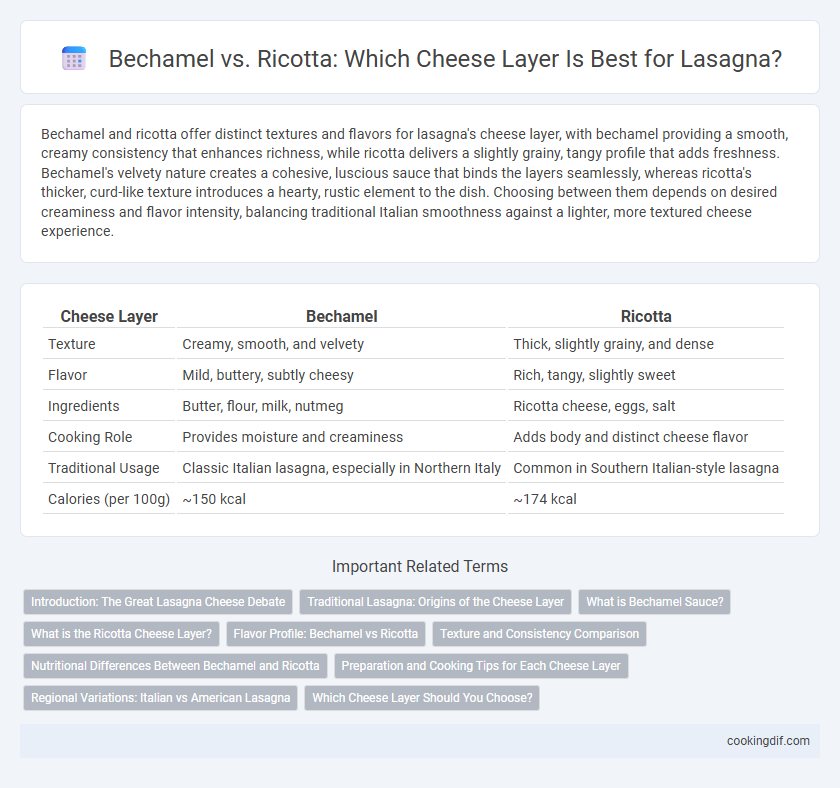Bechamel and ricotta offer distinct textures and flavors for lasagna's cheese layer, with bechamel providing a smooth, creamy consistency that enhances richness, while ricotta delivers a slightly grainy, tangy profile that adds freshness. Bechamel's velvety nature creates a cohesive, luscious sauce that binds the layers seamlessly, whereas ricotta's thicker, curd-like texture introduces a hearty, rustic element to the dish. Choosing between them depends on desired creaminess and flavor intensity, balancing traditional Italian smoothness against a lighter, more textured cheese experience.
Table of Comparison
| Cheese Layer | Bechamel | Ricotta |
|---|---|---|
| Texture | Creamy, smooth, and velvety | Thick, slightly grainy, and dense |
| Flavor | Mild, buttery, subtly cheesy | Rich, tangy, slightly sweet |
| Ingredients | Butter, flour, milk, nutmeg | Ricotta cheese, eggs, salt |
| Cooking Role | Provides moisture and creaminess | Adds body and distinct cheese flavor |
| Traditional Usage | Classic Italian lasagna, especially in Northern Italy | Common in Southern Italian-style lasagna |
| Calories (per 100g) | ~150 kcal | ~174 kcal |
Introduction: The Great Lasagna Cheese Debate
Bechamel and ricotta are the two primary contenders in the lasagna cheese layer, each offering distinct textures and flavors that define the dish's character. Bechamel provides a creamy, smooth consistency with a subtle buttery taste, creating a silky contrast to the tomato sauce and meat layers. Ricotta, rich and slightly grainy, imparts a tangy richness and hearty texture that enhances the traditional Italian lasagna experience.
Traditional Lasagna: Origins of the Cheese Layer
Traditional lasagna recipes from Emilia-Romagna, Italy, emphasize a bechamel cheese layer, which provides a creamy, velvety texture that perfectly complements the rich ragu. In contrast, ricotta cheese, commonly used in Neapolitan-style lasagna, offers a lighter, grainier texture and a slightly tangy flavor profile. The choice between bechamel and ricotta deeply influences the dish's authenticity, texture, and regional identity.
What is Bechamel Sauce?
Bechamel sauce is a creamy white sauce made from butter, flour, and milk, creating a smooth and velvety texture essential for traditional lasagna layers. It serves as a rich, subtle base that complements the bold flavors of tomato sauce and meat, unlike ricotta, which provides a thicker, grainier texture and tangier taste. The use of bechamel in lasagna enhances moisture and creaminess, resulting in a delicate, cohesive dish with balanced richness.
What is the Ricotta Cheese Layer?
The ricotta cheese layer in lasagna is a creamy, mild-textured mixture made from ricotta cheese, often combined with eggs and herbs to create a rich and slightly tangy filling. Unlike the smooth and buttery bechamel sauce, ricotta provides a denser, cheese-forward layer that adds substantial body and moisture to the dish. This layer contributes to the traditional Italian lasagna's hearty consistency while balancing the flavors of meat, tomato sauce, and pasta sheets.
Flavor Profile: Bechamel vs Ricotta
Bechamel sauce offers a rich, creamy texture with a subtle buttery flavor that enhances the lasagna's overall smoothness, while ricotta cheese provides a grainier consistency and a mild, slightly tangy taste that adds depth and lightness to the dish. The bechamel's velvety consistency helps meld the layers seamlessly, creating a luscious mouthfeel, whereas ricotta imparts a fresh dairy flavor with a hint of sweetness. Choosing between bechamel and ricotta significantly influences the lasagna's texture and flavor intensity, tailoring the dish to either a more luxurious or a lighter palate.
Texture and Consistency Comparison
Bechamel sauce delivers a smooth, creamy texture with a velvety consistency that envelops lasagna layers, enhancing moisture without overpowering other ingredients. Ricotta cheese offers a grainier, denser texture, providing a richer mouthfeel and slightly crumbly consistency that adds structure to the cheese layer. The choice between bechamel and ricotta significantly impacts the overall mouthfeel, with bechamel yielding a silkier melt and ricotta imparting a heartier, cheesier bite.
Nutritional Differences Between Bechamel and Ricotta
Bechamel sauce provides a creamy texture with moderate calories and is rich in calcium and vitamin A due to its milk base, while ricotta cheese offers a higher protein content and a similar calcium level but with more fats, including beneficial omega-3 fatty acids. Ricotta's naturally occurring whey proteins contribute to muscle maintenance, making it a favored choice for those seeking a nutrient-dense cheese layer in lasagna. The choice between bechamel and ricotta affects the dish's macronutrient profile, influencing overall calorie count and nutritional benefits.
Preparation and Cooking Tips for Each Cheese Layer
Bechamel sauce requires careful simmering to achieve a smooth, creamy texture without lumps, which enhances the lasagna's silkiness during baking. Ricotta cheese should be well-drained and often mixed with eggs and herbs to prevent excess moisture, ensuring the layers remain firm and flavorful. For optimal results, spread bechamel evenly for a velvety finish, while ricotta layers benefit from gentle folding to maintain their creamy consistency without breaking apart.
Regional Variations: Italian vs American Lasagna
Italian lasagna traditionally features a bechamel cheese layer, providing a smooth, creamy texture that balances rich ragu and tender pasta sheets, prevalent especially in northern regions like Emilia-Romagna. American lasagna commonly substitutes bechamel with ricotta cheese, offering a thicker, tangier layer that adds body and moisture, reflecting adaptations in Italian-American cuisine. These regional variations highlight differing dairy preferences and culinary techniques, shaping distinct flavor profiles between Italian and American lasagna styles.
Which Cheese Layer Should You Choose?
Bechamel sauce offers a creamy, smooth texture with a subtle butter and nutmeg flavor that enhances lasagna's richness, making it ideal for traditional Italian recipes. Ricotta provides a thicker, grainier texture with a mild, slightly tangy taste that adds a hearty, rustic quality to the cheese layer. Choosing between bechamel and ricotta depends on whether you prefer a velvety, custard-like consistency or a denser, more robust cheese presence in your lasagna.
Bechamel vs Ricotta for cheese layer Infographic

 cookingdif.com
cookingdif.com